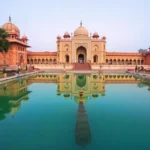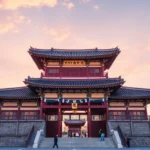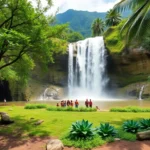30 Interesting Facts About South Korea and Koreans

- The significance of South Korea's flag
- A different perspective on age
- The meaning behind the name 'Korea'
- The importance of blood type in Korean culture
- A beauty obsession
- The ongoing tension with North Korea
- Surveillance culture
- Seafood and culture
- Superstitions in daily life
- The global impact of K-Pop
- Korean cinema on the rise
- The traditional hanbok
- Religious landscape
- Valentine's Day traditions
- The breakdancing capital
- A remarkable literacy rate
- The Hangul writing system
- Mandatory military service
- A concerning suicide rate
- Unique culinary experiences
- The beloved kimchi
- Heating systems
- The popularity of reality TV
- Internet connectivity
- Natural landscapes
- The art of Taekwondo
- The drinking culture
- The jimjilbang experience
When it comes to travel destinations, South Korea has often been overshadowed by its larger neighbors, China and Japan. However, the recent surge in global interest towards South Korea has brought this vibrant country into the spotlight. From the explosive rise of Korean pop culture—like K-Pop and K-Dramas—to its rich history and unique traditions, South Korea has a lot to offer. In this article, we will delve into 30 fascinating facts about South Korea that will not only surprise you but also provide insight into what makes this country so captivating. You’ll find a wealth of interesting facts about Korea that highlight its unique cultural identity and history.
The significance of South Korea's flag
The flag of South Korea, known as the Taegukgi, is rich in symbolism. The white background signifies peace and purity, while the central red and blue circle represents the duality of the universe, akin to yin and yang. Surrounding this circle are four black trigrams that symbolize the four elements: water, air, earth, and fire. This flag embodies the harmony and balance that South Koreans strive for in their culture.
A different perspective on age
In South Korea, age is counted differently than in most parts of the world. When a baby is born, they are considered to be one year old, and everyone ages on New Year's Day rather than on their birthday. This unique system can lead to confusion for travelers when asked about their age, as they will need to add one or two years to their actual age depending on when they visit.
The meaning behind the name 'Korea'
The term "Korea" translates to "land of high mountains and clear rivers." This phrase reflects the country's stunning natural landscapes, which are characterized by rugged mountains and beautiful rivers that have shaped its culture and way of life.
The importance of blood type in Korean culture
In South Korea, blood type is believed to correlate with personality traits. This belief is so prevalent that many people will ask for your blood type before getting to know you, and it even influences relationship compatibility. Here is a brief overview of the personality traits associated with each blood type:
- Type A: Calm, responsible, and detail-oriented.
- Type B: Creative, passionate, and independent.
- Type AB: Rational, charismatic, and adaptable.
- Type O: Outgoing, confident, and natural leaders.
A beauty obsession
South Korea is renowned for its beauty products, and the market is flooded with innovative skincare solutions. This passion for beauty is not limited to women; men also actively participate in skincare routines and even wear makeup. The obsession with appearance has led to South Korea having one of the highest rates of cosmetic surgery in the world. Notably, procedures like double eyelid surgery are considered a rite of passage among young adults. These facts about Korea highlight how deeply ingrained beauty standards are in the culture.
The ongoing tension with North Korea
Despite the historical animosity, it is possible to visit the Demilitarized Zone (DMZ), which separates North and South Korea. This heavily fortified area is a symbolic reminder of the ongoing conflict between the two nations, and guided tours allow you to step into North Korean territory momentarily. It's a profound experience that highlights the stark contrast between the two Koreas.
Surveillance culture
In South Korea, you may feel like you are living in a George Orwell novel due to the numerous CCTV cameras monitoring public spaces. While this is primarily for security reasons, it also reflects a cultural perspective where privacy is viewed differently compared to Western countries.
Seafood and culture
Did you know that South Korea produces approximately 90% of the seaweed consumed globally? This is a testament to the country's rich maritime resources and its integral role in Korean cuisine, where seaweed is used in various traditional dishes. This is just one of the many fun facts about Korea that showcases the country's unique culinary practices.
Superstitions in daily life
South Koreans are known for their superstitions. For instance, writing someone’s name in red ink is considered a bad omen, as the color is associated with death. Additionally, the number four is often avoided due to its phonetic similarity to the word "death." These beliefs influence everyday decisions and behaviors.
The global impact of K-Pop
The phenomenon of K-Pop gained international fame with the release of "Gangnam Style" by PSY in 2012, which became the most-viewed video of the year. This song not only put South Korea on the global music map but also ignited a massive K-Pop wave that continues to captivate audiences worldwide. The influence of groups like BTS and Blackpink can be seen in various aspects of culture, from fashion to social media. If you're looking for fun facts about Korea, K-Pop is a perfect starting point.
Korean cinema on the rise
Following the success of K-Pop, South Korea's film industry has also garnered global recognition. The movie Parasite, which won the Academy Award for Best Picture, marked a significant achievement as the first non-English film to win this honor. The film’s commentary on class disparity has resonated with audiences around the world, showcasing the depth of storytelling in Korean cinema.
The traditional hanbok
The hanbok is a traditional Korean dress characterized by its vibrant colors and elegant design. It consists of two main pieces: the jeogori (top) and chima (skirt). While the hanbok is predominantly worn during festivities and celebrations, many tourists choose to rent one while exploring historical sites like the Gyeongbokgung Palace, where wearing the attire grants free entry.
Religious landscape
Christianity is the most prevalent religion in South Korea, with approximately 27% of the population identifying as Christians, including both Catholics and Protestants. Buddhism follows closely, claiming about 15% of the populace. Nonetheless, a significant portion of the population identifies as atheists, reflecting a diverse spiritual landscape.
Valentine's Day traditions
South Koreans celebrate Valentine's Day uniquely—women gift chocolates to their partners on February 14th, while men reciprocate with gifts on March 14th, known as White Day. This cultural exchange creates a delightful cycle of gifting and affection.
The breakdancing capital
South Korea is home to some of the best breakdancers in the world, with a deeply rooted culture of street dance. The passion for dance extends beyond just performance; it’s a way of life for many young Koreans who participate in competitions and dance battles nationwide.
A remarkable literacy rate
In just a few decades, South Korea transformed its literacy rate from around 22% in 1945 to an impressive 100%. This educational achievement is a cornerstone of the country’s development and reflects its commitment to knowledge and innovation.
The Hangul writing system
The Hangul is the written script of Korean, developed in the 15th century by King Sejong. With its 40 characters—19 consonants and 21 vowels—Hangul is considered one of the most efficient and logical writing systems in the world. Its simplicity and effectiveness have contributed to the high literacy rate in the country.
Mandatory military service
Military service is compulsory for all South Korean men between the ages of 18 and 28, lasting approximately two years. This experience significantly influences young men's lives, shaping their views and responsibilities within society.
A concerning suicide rate
Tragically, South Korea has one of the highest suicide rates globally, particularly among the elderly. Many older adults live below the poverty line, leading to devastating choices as they seek to avoid being a burden on their families.
Unique culinary experiences
One of the most daring dishes in South Korea is sannakji, which consists of live octopus served in pieces that still move on the plate. While it's a delicacy, it poses significant risks if not consumed carefully, as the tentacles can stick to the throat. These culinary delights are just a few of the south korea fun facts that make the country a haven for foodies.
The beloved kimchi
Kimchi, a staple in Korean cuisine, is fermented vegetables—most commonly napa cabbage—seasoned with spices. There are over 100 varieties of kimchi, making it a versatile dish that accompanies almost every meal. Fried chicken is another favorite, showcasing the diverse palate of Korean food culture.
Heating systems
Visitors to South Korea may be surprised to find that many homes use ondol, a traditional heating system that warms the floors. This unique feature is especially comforting during the cold winter months, making South Korean homes cozy and inviting.
The popularity of reality TV
Reality television has taken South Korea by storm, with shows like King of Mask Singer captivating audiences. The concept involves celebrities performing while masked, adding an element of mystery and excitement that has led to adaptations in various countries, including the United States and Germany.
Internet connectivity
South Korea is recognized for having the fastest internet connection in the world, with nearly the entire population enjoying access to high-speed networks. This technological advancement has facilitated a digital culture that permeates daily life.
Natural landscapes
Beyond the bustling cities, South Korea boasts stunning natural landscapes, with approximately 60% of the country covered in forests. Additionally, its coastline stretches over 2,400 kilometers, offering beautiful beaches and scenic views for nature lovers. These south korea facts interesting reflect the country's commitment to preserving its natural beauty.
The art of Taekwondo
Taekwondo, a martial art that originated in Korea over 2,000 years ago, is a source of national pride. It emphasizes high, fast kicks and jumping and spinning kicks, making it both a competitive sport and a form of self-defense.
The drinking culture
South Koreans are known for their lively drinking culture, often gathering to enjoy soju, a popular rice liquor that is both affordable and widely consumed. Beer is also a favorite, with many bars and restaurants offering a variety of local brews.
The jimjilbang experience
Finally, don’t miss the opportunity to visit a jimjilbang, a traditional Korean bathhouse. These establishments provide a unique spa experience where you can relax in saunas, enjoy various baths, and even sleep in communal areas. Just remember that nudity is the norm in bathing areas!
These 30 facts about South Korea offer a glimpse into a country rich in culture, history, and dynamic social norms. Whether you’ve visited or dream of going, Korea has a unique charm that leaves a lasting impression. For those curious about both fun facts about Korea and interesting facts about Korea, the experiences are endless. What aspect of Korean culture fascinates you the most? Join the conversation and share your thoughts!
For more enriching content about travel, culture, and adventure, check out this engaging video that dives deeper into the wonders of South Korea:






Deja una respuesta